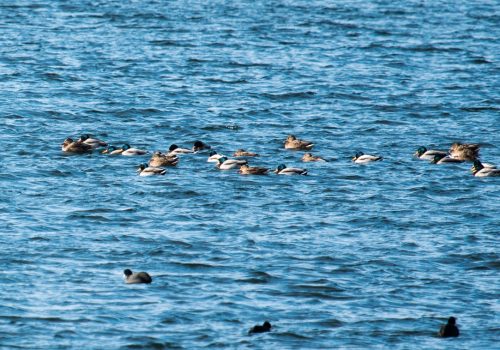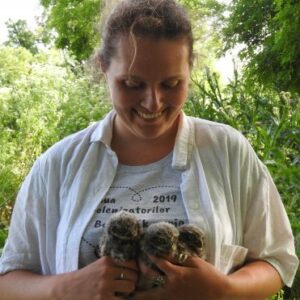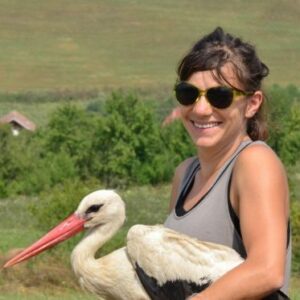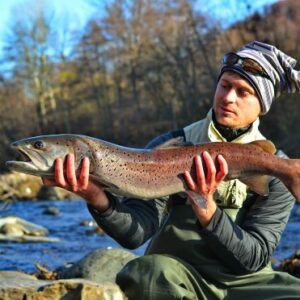
This year “Milvus Group” Bird and Nature Protection Association, together with the
Romanian Ornithological Society (SOR) organized again the annual census of wintering waterfowl (Midwinter Waterbird Census) in Romania. The main period of observations was between the 10
th and 31
st of January, but because it coincided with another, broader survey organized this winter, the last observation day was 4
th of February. The International Waterbird Census (IWC) is coordinated by
Wetlands International and it is organized every year in most countries of the world.
For an easier coordination we split the wetland areas in two parts. Data from one part was processed by Milvus Group and from the other part by the
Romanian Ornithological Society. Besides Milvus Group staff, volunteers also sent their data sheets to us, thus more than twenty people contributed to the data collected by Milvus Group. The observers carried out surveys and gathered data in 119 wetlands from 24 counties.
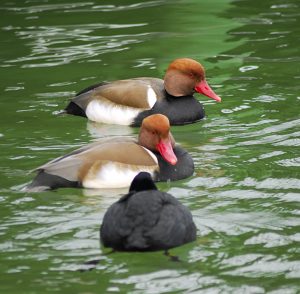
The most visited locations this year were again in Bihor County (35), followed by Mureș County (18) and Brăila County (14), but the size of the areas were not equal. In these counties numerous wetlands with small surface areas were visited, mostly lakes and smaller river courses. There were counties (like Caraș-Severin), where only one or two locations were visited but observations were made on 130 km length route along the Danube River.
Altogether, 149,759 birds belonging to
131 species were observed. Of these, 110,880 belong to water-bird species, which represent 74 % of the total. This however is only the number of “strict waterbirds”. Other species whose year round life cycle is attached to the water (e.g. White-tailed Eagle, Marsh Harrier, Grey Wagtail) could also be added to these.
As in the last year, in 2014 the highest number of observed birds (26,438 individuals) was along the Danube section between Baziaș and Orșova and the lowest number (6 individuals) was recorded in Harghita County, at Frumoasa water reservoir. There were also places where the lakes were completely frozen and the observers saw only some songbirds, raptors or not even one bird.

The observers record the data (observer’s name, contact, name of the surveyed location, date of observation, optical equipment used, disturbing factors and their intensity, size of the area, percentage of ice cover on the water surface, etc.) on a data sheet and totalized the number of individuals of the observed bird species. After returning from the field, they draw the surveyed river section or the shape contour of the visited area on a map.
The most frequently seen waterbird species were the following:
Mallard
(
Anas platyrhynchos) – 46,600, Eurasian Coot (
Fulica atra) – 12,169, Greater White-fronted Goose (
Anser albifrons) – 10,624, Pygmy Cormorant (
Microcarbo pygmaeus) – 4,524 and Great Cormorant (
Phalacrocorax carbo) – 4,132 individuals.
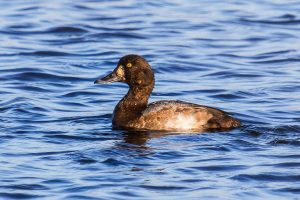
The two large gull species (the Caspian Gull and Yellow-legged Gull) which were not distinguished by many observers and thus were noted simply as
Larus cachinnans/michaellis, were observed together in significant number too, with a total of 2,764 individuals. In similarly large numbers were observed the Mute Swan, Eurasian Teal, Goldeneye and Black-headed Gull, each species with over 2,600 individuals.
Besides waterbirds the five most frequent species were the following songbirds:
Rook (
Corvus frugilegus) – 13,652, Western Jackdaw (
Corvus monedula) – 6,170, Fieldfare (
Turdus pilaris) – 3,393, Tree Sparrow (
Passer montanus) – 2642 and Goldfinch (
Carduelis carduelis) – 2,030.
The rather warm and mild winter, unusual for this period of the year, manifested its effect in the number of observed birds. In the central part of the country, where habitually the winter is hard, now only several lakes were fully or partially frozen. As a result the birds were not concentrated together in wintering areas; larger scattered flocks were found in almost all inland wetlands.
During the midwinter census some observers saw rare and scarce species or species which are uncommon for a certain area or period. These are: Common Loon (
Gavia immer) – 1 individual, Bewick’s Swan (
Cygnus columbianus bewickii) – 37 ind., Long-tailed Duck (
Clangula hyemalis) – 1 ind., Velvet Scoter (
Melanitta fusca) – 9 ind., Common Crane (
Grus grus) – 1 ind., European Golden Plover (
Pluvialus apricaria) – 1 ind., Common Sandpiper (
Actitis hypoleucos) – 1 pld., Common Greenshank (
Tringa nebularia) – 1 ind., Ruff (
Philomachus pugnax) – 17 ind., Jack Snipe (
Lymnocryptes minimus) – 1 ind. As well as Meadow Pipit (
Anthus pratensis) – 1 ind.
As a curiosity for the census, we have to note a presence of a male Mandarin Duck (
Aix galericulata), a non-native bird species in Europe, observed in Satu Mare County.
We hereby would like to thank all participants for the provided data and their efforts in this work.
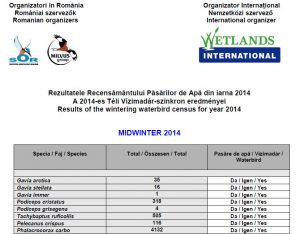
 This year “Milvus Group” Bird and Nature Protection Association, together with the Romanian Ornithological Society (SOR) organized again the annual census of wintering waterfowl (Midwinter Waterbird Census) in Romania. The main period of observations was between the 10th and 31st of January, but because it coincided with another, broader survey organized this winter, the last observation day was 4th of February. The International Waterbird Census (IWC) is coordinated by Wetlands International and it is organized every year in most countries of the world.
For an easier coordination we split the wetland areas in two parts. Data from one part was processed by Milvus Group and from the other part by the Romanian Ornithological Society. Besides Milvus Group staff, volunteers also sent their data sheets to us, thus more than twenty people contributed to the data collected by Milvus Group. The observers carried out surveys and gathered data in 119 wetlands from 24 counties.
This year “Milvus Group” Bird and Nature Protection Association, together with the Romanian Ornithological Society (SOR) organized again the annual census of wintering waterfowl (Midwinter Waterbird Census) in Romania. The main period of observations was between the 10th and 31st of January, but because it coincided with another, broader survey organized this winter, the last observation day was 4th of February. The International Waterbird Census (IWC) is coordinated by Wetlands International and it is organized every year in most countries of the world.
For an easier coordination we split the wetland areas in two parts. Data from one part was processed by Milvus Group and from the other part by the Romanian Ornithological Society. Besides Milvus Group staff, volunteers also sent their data sheets to us, thus more than twenty people contributed to the data collected by Milvus Group. The observers carried out surveys and gathered data in 119 wetlands from 24 counties.
 The most visited locations this year were again in Bihor County (35), followed by Mureș County (18) and Brăila County (14), but the size of the areas were not equal. In these counties numerous wetlands with small surface areas were visited, mostly lakes and smaller river courses. There were counties (like Caraș-Severin), where only one or two locations were visited but observations were made on 130 km length route along the Danube River.
Altogether, 149,759 birds belonging to 131 species were observed. Of these, 110,880 belong to water-bird species, which represent 74 % of the total. This however is only the number of “strict waterbirds”. Other species whose year round life cycle is attached to the water (e.g. White-tailed Eagle, Marsh Harrier, Grey Wagtail) could also be added to these.
As in the last year, in 2014 the highest number of observed birds (26,438 individuals) was along the Danube section between Baziaș and Orșova and the lowest number (6 individuals) was recorded in Harghita County, at Frumoasa water reservoir. There were also places where the lakes were completely frozen and the observers saw only some songbirds, raptors or not even one bird.
The most visited locations this year were again in Bihor County (35), followed by Mureș County (18) and Brăila County (14), but the size of the areas were not equal. In these counties numerous wetlands with small surface areas were visited, mostly lakes and smaller river courses. There were counties (like Caraș-Severin), where only one or two locations were visited but observations were made on 130 km length route along the Danube River.
Altogether, 149,759 birds belonging to 131 species were observed. Of these, 110,880 belong to water-bird species, which represent 74 % of the total. This however is only the number of “strict waterbirds”. Other species whose year round life cycle is attached to the water (e.g. White-tailed Eagle, Marsh Harrier, Grey Wagtail) could also be added to these.
As in the last year, in 2014 the highest number of observed birds (26,438 individuals) was along the Danube section between Baziaș and Orșova and the lowest number (6 individuals) was recorded in Harghita County, at Frumoasa water reservoir. There were also places where the lakes were completely frozen and the observers saw only some songbirds, raptors or not even one bird.
 The observers record the data (observer’s name, contact, name of the surveyed location, date of observation, optical equipment used, disturbing factors and their intensity, size of the area, percentage of ice cover on the water surface, etc.) on a data sheet and totalized the number of individuals of the observed bird species. After returning from the field, they draw the surveyed river section or the shape contour of the visited area on a map.
The most frequently seen waterbird species were the following: Mallard (Anas platyrhynchos) – 46,600, Eurasian Coot (Fulica atra) – 12,169, Greater White-fronted Goose (Anser albifrons) – 10,624, Pygmy Cormorant (Microcarbo pygmaeus) – 4,524 and Great Cormorant (Phalacrocorax carbo) – 4,132 individuals.
The observers record the data (observer’s name, contact, name of the surveyed location, date of observation, optical equipment used, disturbing factors and their intensity, size of the area, percentage of ice cover on the water surface, etc.) on a data sheet and totalized the number of individuals of the observed bird species. After returning from the field, they draw the surveyed river section or the shape contour of the visited area on a map.
The most frequently seen waterbird species were the following: Mallard (Anas platyrhynchos) – 46,600, Eurasian Coot (Fulica atra) – 12,169, Greater White-fronted Goose (Anser albifrons) – 10,624, Pygmy Cormorant (Microcarbo pygmaeus) – 4,524 and Great Cormorant (Phalacrocorax carbo) – 4,132 individuals.
 The two large gull species (the Caspian Gull and Yellow-legged Gull) which were not distinguished by many observers and thus were noted simply as Larus cachinnans/michaellis, were observed together in significant number too, with a total of 2,764 individuals. In similarly large numbers were observed the Mute Swan, Eurasian Teal, Goldeneye and Black-headed Gull, each species with over 2,600 individuals.
Besides waterbirds the five most frequent species were the following songbirds: Rook (Corvus frugilegus) – 13,652, Western Jackdaw (Corvus monedula) – 6,170, Fieldfare (Turdus pilaris) – 3,393, Tree Sparrow (Passer montanus) – 2642 and Goldfinch (Carduelis carduelis) – 2,030.
The rather warm and mild winter, unusual for this period of the year, manifested its effect in the number of observed birds. In the central part of the country, where habitually the winter is hard, now only several lakes were fully or partially frozen. As a result the birds were not concentrated together in wintering areas; larger scattered flocks were found in almost all inland wetlands.
During the midwinter census some observers saw rare and scarce species or species which are uncommon for a certain area or period. These are: Common Loon (Gavia immer) – 1 individual, Bewick’s Swan (Cygnus columbianus bewickii) – 37 ind., Long-tailed Duck (Clangula hyemalis) – 1 ind., Velvet Scoter (Melanitta fusca) – 9 ind., Common Crane (Grus grus) – 1 ind., European Golden Plover (Pluvialus apricaria) – 1 ind., Common Sandpiper (Actitis hypoleucos) – 1 pld., Common Greenshank (Tringa nebularia) – 1 ind., Ruff (Philomachus pugnax) – 17 ind., Jack Snipe (Lymnocryptes minimus) – 1 ind. As well as Meadow Pipit (Anthus pratensis) – 1 ind.
As a curiosity for the census, we have to note a presence of a male Mandarin Duck (Aix galericulata), a non-native bird species in Europe, observed in Satu Mare County.
We hereby would like to thank all participants for the provided data and their efforts in this work.
The two large gull species (the Caspian Gull and Yellow-legged Gull) which were not distinguished by many observers and thus were noted simply as Larus cachinnans/michaellis, were observed together in significant number too, with a total of 2,764 individuals. In similarly large numbers were observed the Mute Swan, Eurasian Teal, Goldeneye and Black-headed Gull, each species with over 2,600 individuals.
Besides waterbirds the five most frequent species were the following songbirds: Rook (Corvus frugilegus) – 13,652, Western Jackdaw (Corvus monedula) – 6,170, Fieldfare (Turdus pilaris) – 3,393, Tree Sparrow (Passer montanus) – 2642 and Goldfinch (Carduelis carduelis) – 2,030.
The rather warm and mild winter, unusual for this period of the year, manifested its effect in the number of observed birds. In the central part of the country, where habitually the winter is hard, now only several lakes were fully or partially frozen. As a result the birds were not concentrated together in wintering areas; larger scattered flocks were found in almost all inland wetlands.
During the midwinter census some observers saw rare and scarce species or species which are uncommon for a certain area or period. These are: Common Loon (Gavia immer) – 1 individual, Bewick’s Swan (Cygnus columbianus bewickii) – 37 ind., Long-tailed Duck (Clangula hyemalis) – 1 ind., Velvet Scoter (Melanitta fusca) – 9 ind., Common Crane (Grus grus) – 1 ind., European Golden Plover (Pluvialus apricaria) – 1 ind., Common Sandpiper (Actitis hypoleucos) – 1 pld., Common Greenshank (Tringa nebularia) – 1 ind., Ruff (Philomachus pugnax) – 17 ind., Jack Snipe (Lymnocryptes minimus) – 1 ind. As well as Meadow Pipit (Anthus pratensis) – 1 ind.
As a curiosity for the census, we have to note a presence of a male Mandarin Duck (Aix galericulata), a non-native bird species in Europe, observed in Satu Mare County.
We hereby would like to thank all participants for the provided data and their efforts in this work.


